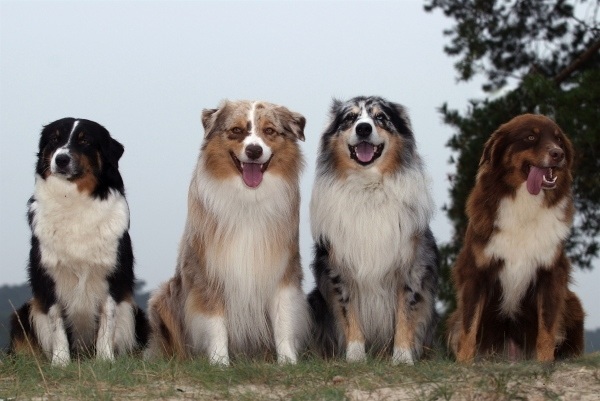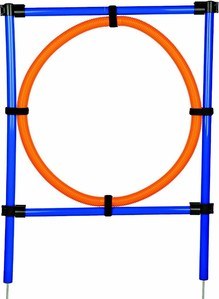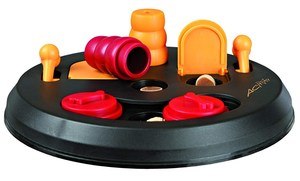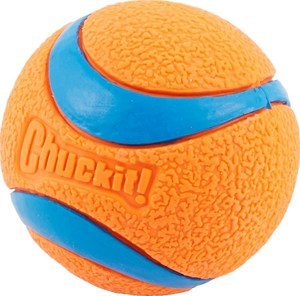Good Mates: The Best Toys for Australian Shepherds
Equipped with an alluring wavy coat, colorful eyes, and a work ethic that seemingly doesn’t have an off-switch, the Australian Shepherd arguably epitomizes the concept of “beauty and the beast” better than any other dog. This breed also plays as hard as he works. So what toys suit them best?
OUR PICKS FOR THE TOP TOYS FOR AUSTRALIAN SHEPHERDS
How do Australian Shepherds Handle Play Time?

An Aussie needs ample activity every day to be happy, and we’re not just talking about a slow stroll around the block, either. Expect to spend about a half-hour to an hour each day doing physical activity to satiate his athletic side. Running, fetch, or even obedience training are all excellent work out choices.
Because the Aussie is a natural athlete, you may want to conduct play sessions that best tap into this natural urge of his. This is a dog that would thrive playing a simple game of Frisbee, for example. Setting up an obstacle course in your backyard is also a great way for the breed to burn energy, provided you have ample backyard space.
With that being said, the actual style of play you choose to engage should be greatly dependent on the age of your Aussie. The breed's level of exercise should be closely monitored as a pup, as running on a hard surface or doing tons of jumping could cause long-term skeletal or joint issues. The threat of damage dissipates going into adulthood.
The need for stimulation also doesn’t stop from a physical standpoint. Aussies are immensely intelligent, and they need to engage in play styles built to keep their mind occupied. If you don’t, they can become bored and end up showing no mercy on your furniture.
As you play with him and/or train him, make sure that you clearly communicate that you’re in control of the activity. If you don’t, he may resort to alpha dog status and deploy herding techniques like nipping. This could especially be the case if he’s not trained to play with children, as he may naturally assume the kids are submissive.
Our Recommendations
Dog Agility Training Hoop
As fun as a game of fetch can be with your Aussie, this breed is practically custom built for advanced athletics. If you have the gumption to train your pooch to show off his skills, the 3 in 1 Agility Starter Kit is a good place to begin.
The reason it works is because the trio of items – a jump hoop, a jump bar, and a dog training pole – is designed to give your Aussie a gentle foray into the world of athletics. Your Aussie is bright enough to figure out how to play with the objects. However, the toys are constructed to build the confidence needed to excel during playtime.
The toys will also boost your confidence as an Aussie owner. If you’ve never entered the world of canine sports before, you may have doubts that you’ll do a good job. The easy design of these contraptions will work to erase such doubt.
It’s important that you don’t overlook your Aussie’s need for mental stimulation. It could be easy to do so, especially if you are concentrating on athletic stuff. But your possessions could pay the price if you end up bypassing this crucial brain-centric need.
The reason the TRIXIE Dog Activity Flip Board works so well is because it provides your Aussie with multiple outlets to stimulate his mind in one convenient location. Each puzzle on the board offers a different puzzle with a different solution, leading to extended periods of challenging fun for your pooch.
And of course, no puzzle toy would be complete without providing your dog the promise of obtaining a treat for a job well done. This toy features plenty of places to stash treats, none of which offer shortcuts that will allow your dog to “cheat.” This fail-safe will keep him engaged mentally until the very last goodie is uncovered.
This also makes for a great toy if you're planning on leaving your Aussie alone for an extended period of time, such as during the week if you have to head to work. Aussies are infamous for not being able to handle separation anxiety, and if they don't give them something to keep them occupied, they'll create a task – much to your furniture's chagrin.
The one common thread that connects the physical and mental based toys is that both play to the dog's inherent nature of being a smart worker. The athleticism and intelligence needed to be a top-notch herding dog are embedded in the breed's DNA, and there are no signs they will be bred out anytime soon.
If you’re planning on bringing an Aussie into your home, you better be prepared to allow him to feed into these instincts. If you do, you will find your Aussie to be a loyal, lovable dog whose personality and energy will be every bit as joy-inducing as his breathtaking coat.
What are the Best Types of Toys for the Breed?
The toys that will make your Aussie happiest involve things that will get him to move his body. Sturdy balls or objects that can be used for a game of fetch will help him burn his energy in a fun, exciting way. If you do play fetch, be prepared for the game to last an extended period of time.
If you want to take the outdoor play to the next level, you can always train your Aussie to play dog sports. Frisbee training easily comes to mind, in part because the breed looks so majestic chasing down discs. If you have ample space in your backyard, you can also build and obstacle course or engage him in some flyball.
When you and your pooch is ready for some mellow play, you can engage his brain with some puzzle toys. Because Aussies are so bright, they will take great delight in trying to figure out a toy that requires brainpower. Just be sure that it’s well-built, or he may find destructive ways to solve things.
What are the Worst Types of Toys for the Breed?
Sedentary chew toys that don’t feature a puzzle component aren’t great for Aussies, simply because they don’t have much to offer in terms of physical or mental engagement. At best, they will ignore these types of toys. At worst, they will destroy them.
Australian Shepherds: The Vitals
Australian Shepherds come with a dirty little secret: despite their cosmopolitan name, they really don’t originally hail from Australia. The origins of the breed stem from the Basque region of Spain, and they are thought to come to the US during the 19th century Gold Rush by way of Down Under.
Other than little bit of geographic misdirection, the Aussie (as they are called) is just about what savvy dog aficionados may expect from a working breed with the word “shepherd” in its full moniker. Bred to herd sheep and other animals, the Aussie is a robust, take-charge breed that is at their best when he’s able to put his brains and energy to use.
To merely say that the Aussie is a high-energy breed is still a bit of an understatement. This is an active breed that has pure disdain for the sedentary lifestyle. This zest for keeping busy makes the breed a natural athlete – one that is a major player on the competitive dog sport circuit.
This dog is no dumb jock, however. In fact, an Aussie’s brainpower is so astute, you may be able to train him to do some chores around the house, such as pick up dirty dishes and bring them to you. We’re not going to say that he’d be more helpful than your lazy teenager, but we’ll leave that up to you.
Speaking of kids, the Aussie’s attitude toward children can be largely controlled by diligent training. Assuming you don’t have a herd of something in your home, an untrained Aussie may resort to herding your kids to satisfy his instinct. This could include unpleasant behaviors like deeply staring at them, barking, and even nipping.
Aussies also tend to be very aloof with strangers, simply because he’s a protective breed that is constantly on the lookout for his owner. This attitude, combined with his mighty work ethic, has made him a great breed for police work, being a guide dog, or being involved in search and rescue.
Frankly, the Aussie may not be the wisest choice if you are a novice dog owner, just because there's a lot to do to satisfy his instinctual needs. Yet when properly trained, this herding dog with a gorgeous coat can be a tremendous family dog that will defend their owner at all costs.







